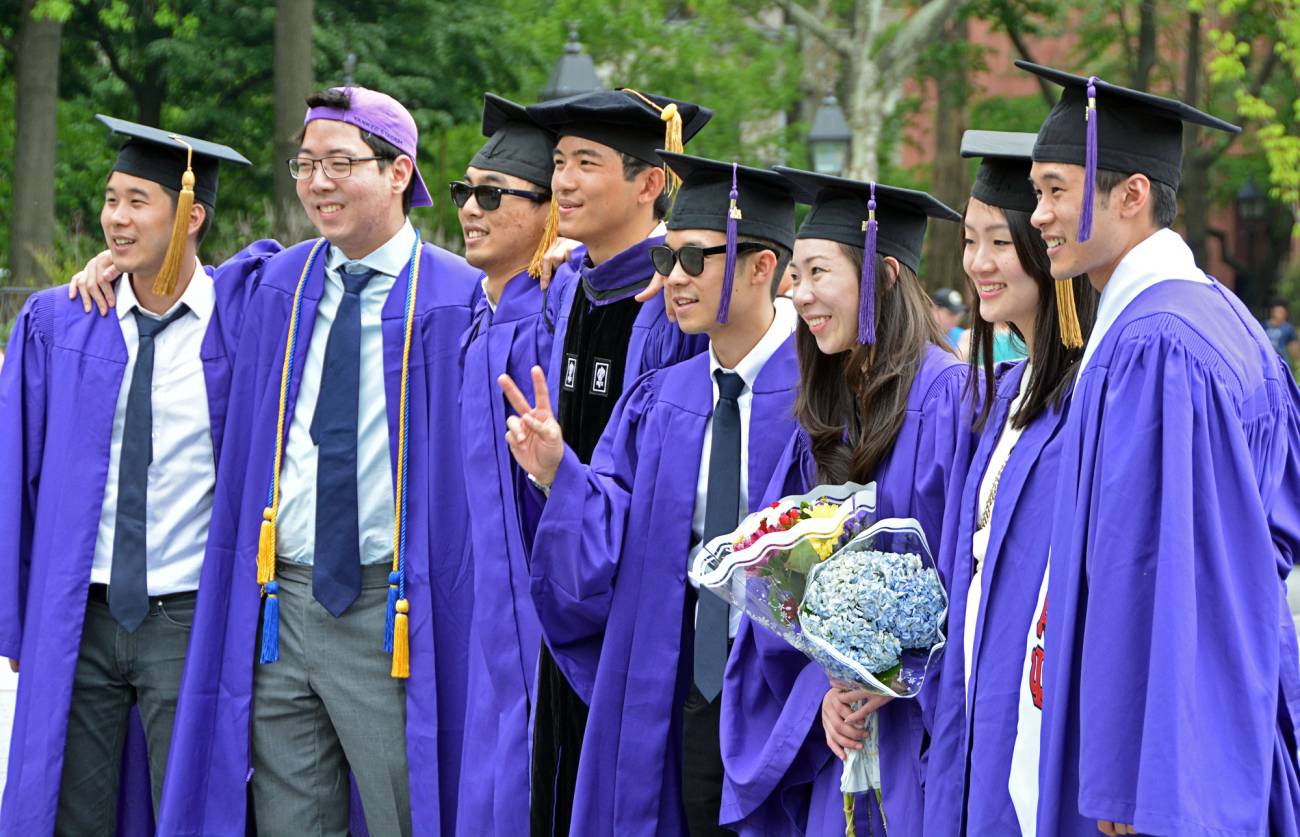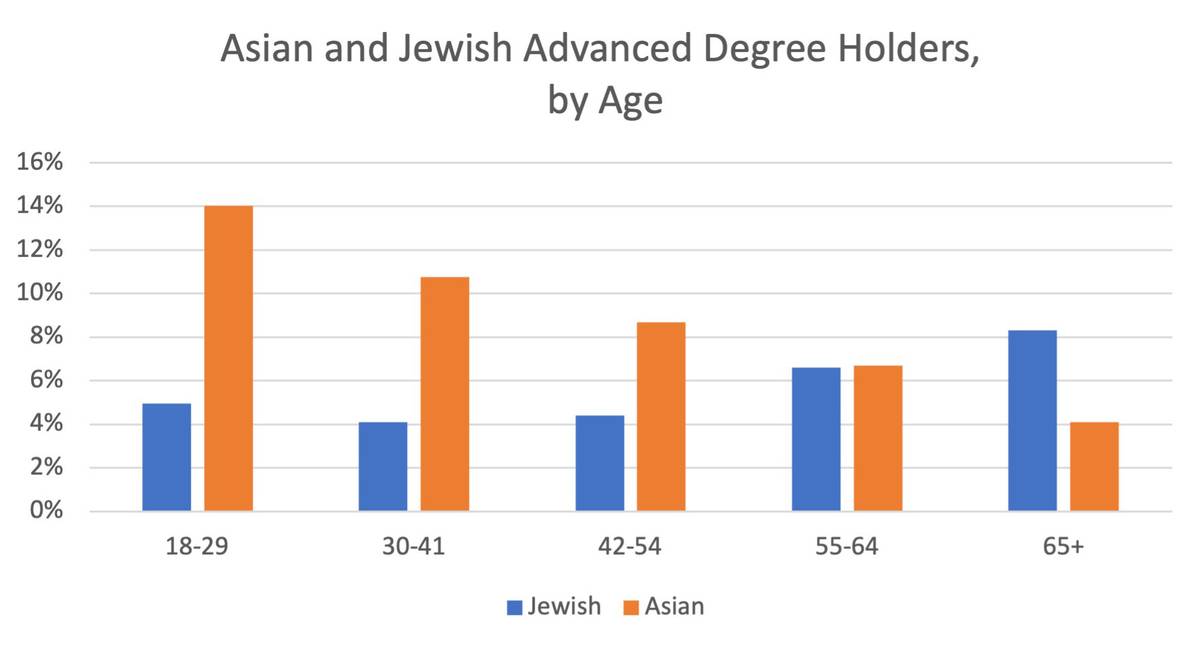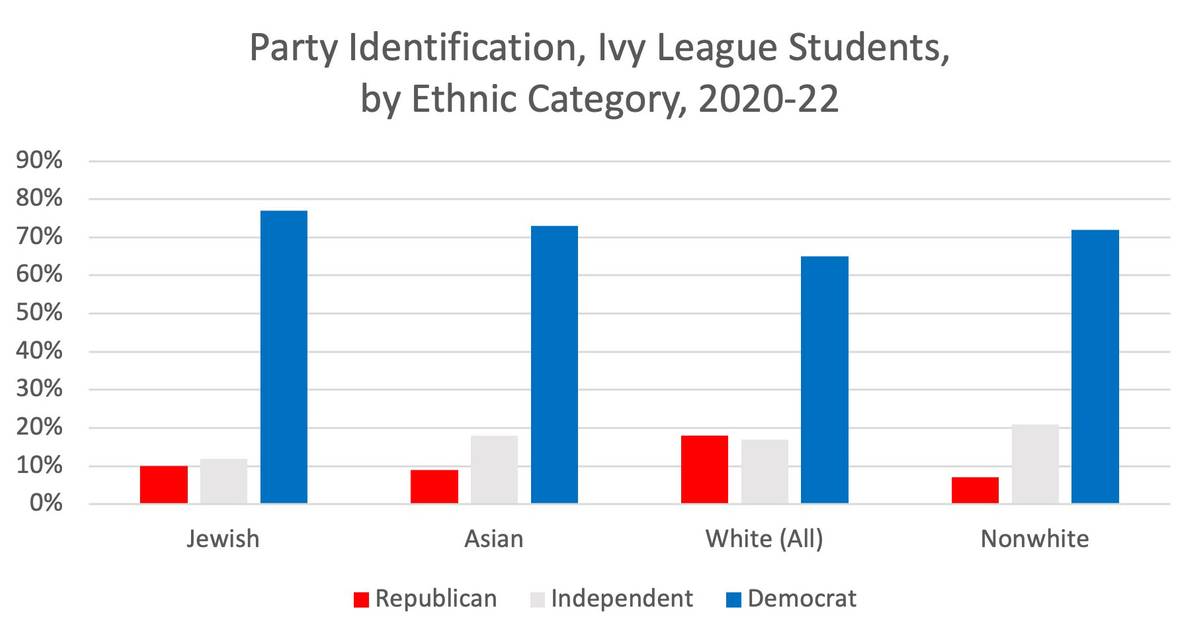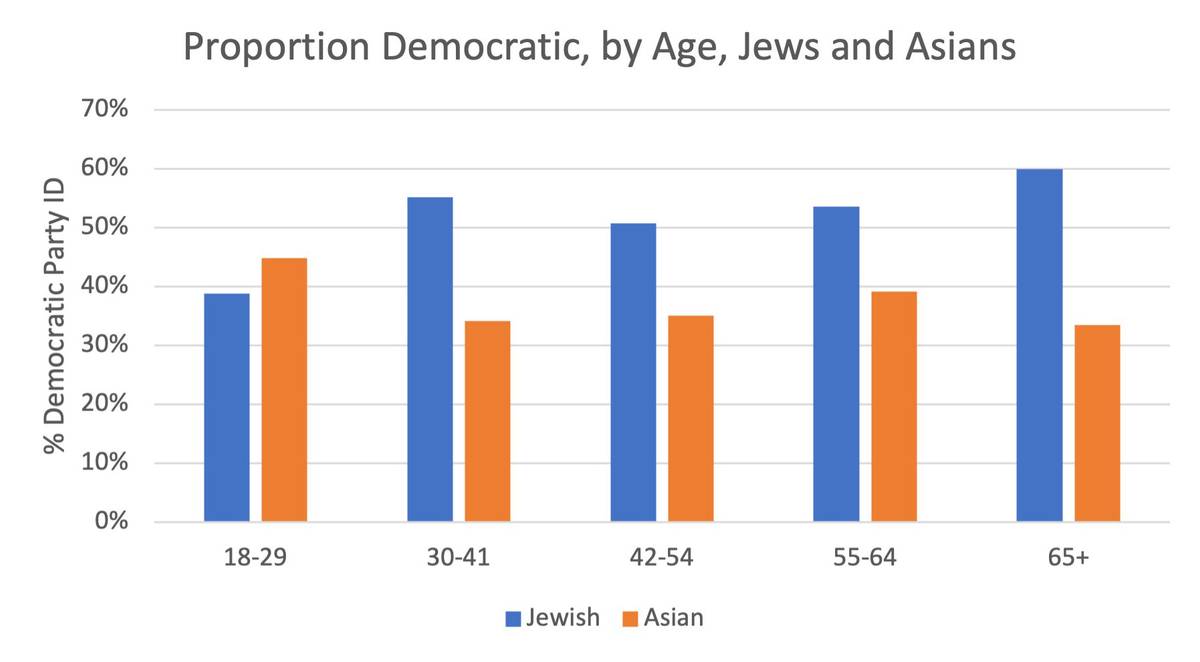Trading Places
Asian Americans are becoming more liberal as they enter the elite, while downwardly mobile Jews are moving to the right



Kanye West’s paranoia notwithstanding, Jews are slowly fading from the American elite. A few decades hence, we may look back at the age of Jewish prominence, from roughly the 1920s to the 2000s, as a relic from a bygone golden age. While Jews and Asians share much in common, the differences between these groups are more striking. The status decline of the former contrasts sharply with the rise of the latter. Relatedly, the two groups are also on different political trajectories, with Jews likely to become more conservative while upwardly mobile Asian Americans move toward the Democrats, and become a larger share of the liberal establishment.
American Jews are bifurcating in two directions that will likely ensure that they become less prominent in American cultural life: toward assimilation and identity loss on the one hand, and toward ethnoreligious conservatism on the other. What is shrinking is the Goldilocks zone wherein Jews retained enough of their identity and educational ethos to succeed in the secular world without veering toward the Scylla of career-limiting ultra-Orthodoxy or the Charybdis of post-ethnic individualism.
Now it seems that Jews are moving toward both Scylla and Charbydis at the same time. On the one hand, Jews who are not Orthodox are embracing liberal secularism, intermarriage, symbolic ethnicity and post-ethnicity. Pew data shows that around half of non-Orthodox Jews have married non-Jews, rising to 72% among those tying the knot in the 2010s. Among Jews with one non-Jewish parent, 82% have married non-Jews compared to just 34% of those with two Jewish parents. While 91% of Orthodox Jews say it is very important that their grandchildren be Jewish, just 4% of nonreligious Jews agree.
Young ethnic Jews are either more Orthodox or more secular-liberal than their parents. Those taking the liberal path place little value on their offspring identifying as Jewish or marrying a Jew. I’m a good example: As someone raised in a secular environment, with an ethnically Jewish father and a half-Chinese, half-Hispanic mother, I am married to a non-Jew. The net result of this process is to water down the distinctive Jewish identity and ethos. Affluence may also be playing a role in blunting Jews’ willingness to work, strive, and save as their ancestors did.
On the other hand, those who are Orthodox, notably the ultra-Orthodox, are growing rapidly as a share of the religiously observant Jewish population because they have a fourfold fertility advantage over non-Orthodox Jews. Some project that the ultra-Orthodox will comprise the majority of observant Jews by 2050. Ultra-Orthodox Jews value religious rote learning, not secular science and elite careers. Meanwhile, the trading and literacy skills that gave Jews an early advantage in the knowledge economy are now better exemplified by the fast-growing Asian population.
Consider the following:
In 1925, 25% of Harvard’s incoming class was Jewish. In 2020, according to Shira Telushkin, a mere 6% identify their religion as Jewish. The infamous 15% quotas placed on Jews in the Ivy League in the early and mid 20th century would hardly be necessary today, when just 7% of Ivy League students in the 100,000-strong Foundation for Individual Rights and Expression (FIRE) surveys of 2020-22 identify their religion as Jewish.
This is part of a wider change that extends well beyond the Ivies. According to the Cooperative Congressional Election Study (CCES), which samples 60,000 voters, the share of Jews with advanced degrees has been stagnating. Among those over 40, Jews are about 15% more likely to possess a graduate degree than Asians. But for Americans under 30, Asians are slightly more likely to have a master’s or doctoral degree than Jews. The same pattern holds for income, with Jews well ahead of Asians among middle and older age groups, but level-pegging among those under 30. Put this together with the fact that Asians are the fastest-growing racial category and the result is a wholesale transformation of the country’s most educated elite.
As figure 1 shows, among Americans 65 and over, 8% of master’s and doctoral degree-holders are Jewish and a mere 4% Asian. By contrast, fully 14% of advanced degree-holders under 30 are Asian, dwarfing the Jews’ 5% share. A combination of rising diversity and the dynamics taking place within the Jewish population likely underlie the shift.

Now let’s consider a random sample of 1,100 elite American academics, mainly in the social sciences and humanities (SSH), from surveys I conducted in 2020. There is some statistical noise due to the relatively small sample, but the trend is clear. As figure 2 shows, 18% of young professors aged 30 and under are Asian, while just 6% are Jewish. But among older elite SSH academics over 65, fully 24% are Jewish while none are Asian. The situation is probably more dramatic in the hard sciences, where Asians are known to especially excel. What this represents is an ethnic turnover in the composition of America’s colleges and universities.
The decline of Jews and rise of Asians partly reflects a wider diversification of university staff and students, with whites declining as minorities rise. Among those over 65, just 5% of these academics are nonwhite while among the youngest cohort the minority share approaches 30%. Richard Alba writes that the retirement of the baby boomers is creating more space at the top for minorities to take up places in the American elite. Even so, as figure 2 illustrates, the lion’s share of minority growth comes from Asians while Jews have experienced considerably sharper elite decline than other whites. As we saw with elite students, here is evidence of a stunning change, akin to the de-WASPification of the American elite from the 1960s as Catholics and Jews poured into the C-suites and Congress.

It could be argued that surveys of elite students and professors are failing to capture ethnic Jews who no longer identify as Jewish by religion. It may be that among young elite students and academics there is a somewhat larger penumbra of whites like myself with fractional Jewish heritage. But even this broad definition, which encompasses many whose Jewish identity is episodic or attenuated, cannot account for the decline.
Why? Pew data show that 76% of ethnic Jews over 65 are “Jews by religion,” while only 56% of young ethnic Jews are. The share who say they have no religion is twice as high (25%) among young ethnic Jews than among the old (12%). But this modest religious difference cannot explain the seismic two- to four-fold drop in Jewish presence among elite students and professors. Moreover, nonreligion has long been high among academics. In fact the share of the professoriate who claim they have no religion is stable across age groups in my data. White Christians, who should also have declined sharply if secularization was the culprit, show nothing like the drop across age groups that white Jews do. I am also not convinced that younger and older academics marking “Jewish” in the religion box are radically different in outlook.
Bottom line: There are a lot fewer young Jews, religious or otherwise, in the educational elite than in the past. Asians, and, to a lesser degree, upwardly mobile white gentiles, Blacks and Hispanics, have largely taken their place.
While Jews and Asians share much in common, the status decline of the former contrasts sharply with the rise of the latter.
The world looks quite different from an ethnic vantage point of exceptional success and growth than it does from one of decline. Throw in an inhospitable ideological climate and the ingredients are there for resentment. For example, at George Washington University, flyers with the words, “Zionists f** off” were affixed to the local Hillel chapter. At Harvard, the university newspaper, The Crimson, penned an editorial in support of “Boycott, Divest, Sanction and a Free Palestine.” The rise of institutional identity politics based on diversity, equity and inclusion (DEI) and critical race theory (CRT) that excludes Jews is also well in train. While there is little question that Jews and Asians both bear the brunt of affirmative action, the anti-white focus of the contemporary DEI agenda in organizations and CRT in schools and universities places Jews more squarely in the firing line. Anti-Zionist sentiment adds salt to the wound for many Jewish academics and students.
Might Jews begin to tilt right, toward a more populist conservatism? There is little concrete evidence of this as yet. As figure 3 shows, Jewish Ivy League students are more likely than their non-Jewish white peers and about as likely as their Asian classmates to lean liberal and Democratic. That is, young Jews attending elite universities continue to lean left by an overwhelming margin. This is less apparent among young Jews in less prestigious colleges, where they are about twice as likely to be Republican. Even so, exit polls in 2016 and 2020 still show Jews overall voting 70-30 for the Democrats over the GOP.

What is likely to shift the dial, however, is the evolving theological composition of American Jewry. Pew data shows that 17% of Jews under 30 are Orthodox, of which 11% are ultra-Orthodox. This compares to just 3% Orthodox among the over-65s. When we factor in the markedly higher rate of nonreligion (40%) among young Jews compared to the old (16%), this suggests that a third of young observant Jews are Orthodox compared to only 4% of older observant Jews.
Pew’s breakdown of partisanship by theology shows that Orthodox Jews lean 75-20 Republican while non-Orthodox and nonreligious Jews incline toward the Democrats by a similar margin. As the composition of American Jewry shifts—one funeral and one birth at a time—we should see a steady political transformation of the nation’s Jews from blue to red, much as Israel’s electorate has shifted right over time.
In addition, a considerable number of those with part-Jewish ancestry have converged with the white American mainstream in their partisanship. Pew data show that there is a group that is half as large as the Jewish population made up of those who have a Jewish parent or were raised Jewish but no longer consider themselves to be so. Among this group, the proportions of Republican and Democratic supporters are close to even. To the extent intermarriage creates more of these quasi-Jews, we might expect the Democratic inclination of Jewish descendants to erode.
It’s also worth noting that Jews in America are now relatively unique among global Jewry in leaning left, and that their British, French, Israeli and Canadian counterparts now tilt right. Demography is the most predictive of the social sciences and as a result we should be able to see these trends emerging among the youngest cohort of American Jews in the coming years.
To wit, Pew data show that the Democrats’ advantage over the GOP among Jews is slightly narrower among the under-30s than those 65 and over. This is in marked contrast to young adults overall, who are far more likely to be Democrats than their parents and grandparents. Meanwhile, comparing Asians and Jews in figure 4 shows that among respondents under 30, Asians are more likely to identify as Democratic than Jews, whereas in older age categories, Jews are considerably more Democratic than Asians.

The realignment of American politics has seen cultural questions such as immigration or the culture wars eclipse free market versus welfare state considerations when it comes to sorting people into parties. Wealthier voters are trending Democratic while working-class and traditional voters are migrating toward the Republicans. With this in mind, Asian upward mobility is producing a more Democratic orientation while traditionalism and assimilation are shifting Jews to the right.
In the 20th century, Jews played an important role in reproducing and enriching the American tradition. One of the big stories of the next half-century will be how the transition from a Jewish- to an Asian-inflected elite will affect the country’s culture and identity.
Eric Kaufmann is Professor of Politics at Birkbeck, University of London. His latest book is Whiteshift: Populism, Immigration and the Future of White Majorities.